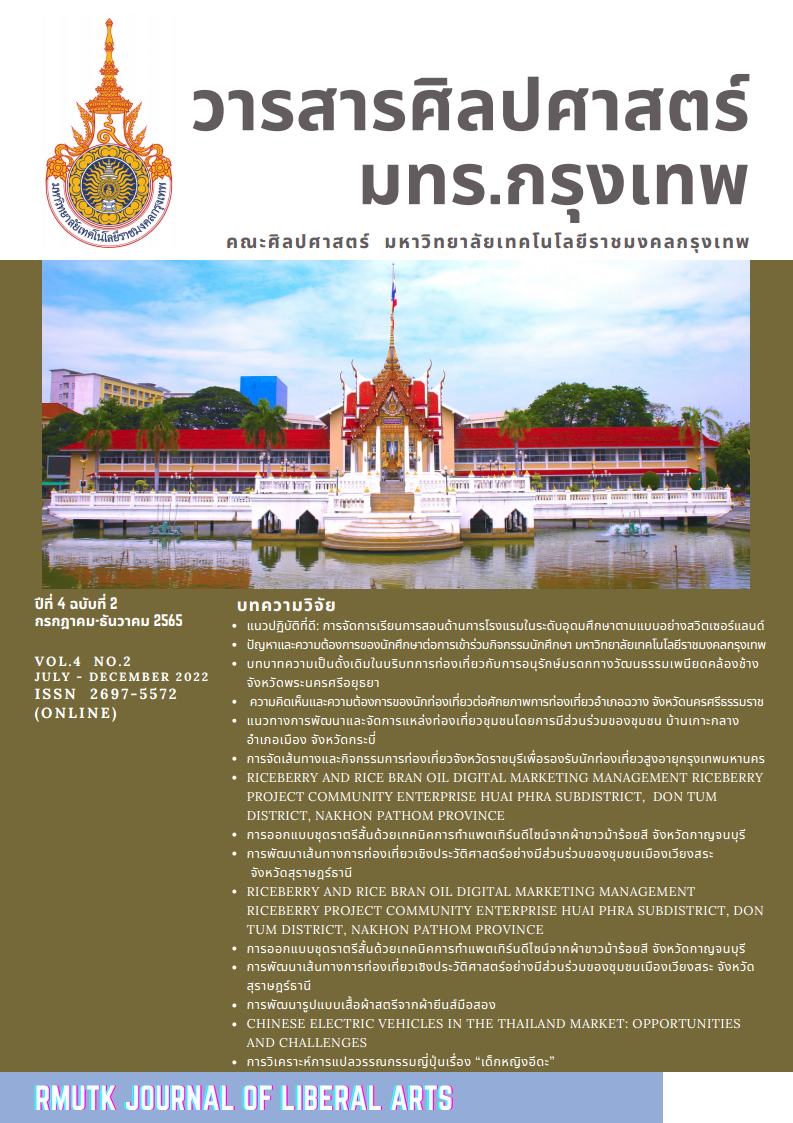การพัฒนารูปแบบเสื้อผ้าสตรีจากผ้ายีนส์มือสอง
Main Article Content
บทคัดย่อ
การวิจัยครั้งนี้มีวัตถุประสงค์เพื่อ 1) เพื่อศึกษารูปแบบเสื้อผ้าสตรีจากผ้ายีนส์มือสอง 2) เพื่อออกแบบเสื้อผ้าสตรีจากผ้ายีนส์มือสอง 3) เพื่อประเมินความพึงพอใจในการพัฒนารูปแบบเสื้อผ้าสตรีจากผ้ายีนส์มือสอง กลุ่มตัวอย่างเป็นนักศึกษาสาขาวิชาเทคโนโลยีเสื้อผ้าและแพตเทิร์น คณะเทคโนโลยีคหกรรมศาสตร์ มหาวิทยาลัยเทคโนโลยีราชมงคลกรุงเทพ จำนวน 50 คน เครื่องมือที่ใช้ในการเก็บข้อมูล ได้แก่ แบบประเมินความพึงพอใจสำหรับกลุ่มตัวอย่างที่มีต่อเสื้อผ้าสตรีจากผ้ายีนส์มือสอง วิเคราะห์ข้อมูลโดยการหาค่าร้อยละ ค่าเฉลี่ย และส่วนเบี่ยงเบนมาตรฐาน จากการศึกษารูปแบบเสื้อผ้าสตรีจากผ้ายีนส์มือสอง พบว่า เสื้อผ้าจากผ้ายีนส์มือสองเป็นเสื้อผ้าที่ออกแบบจากการนำเอาแนวคิดการผสมผสานระหว่างผ้ายีนส์ที่มีความหนาและแข็งกระด้างมาตัดทอนด้วยการใช้เทคนิคการตัดเย็บเข้ามา เช่น การจีบรูด การแทรกผ้า การตัดต่อผ้า และนำเอาวัสดุตกแต่ง เช่น สายโลหะ พู่ ชายครุย รอยขาดมาใช้ในการออกแบบและตัดเย็บเพื่อให้เสื้อผ้าดูมีความอ่อนนุ่มน่าสวมใส่มากขึ้นสร้างจุดเด่นในการออกแบบ เพื่อตอบสนองความต้องการของวัยรุ่น การพัฒนารูปแบบเสื้อผ้าสตรีจากผ้ายีนส์มือสองมีขั้นตอนการดำเนินงานดังต่อไปนี้ ผู้วิจัยออกแบบเสื้อผ้าสตรีจากผ้ามือสอง จำนวน 6 ชุด คัดเลือกรูปแบบโดยผู้เชี่ยวชาญจำนวน 5 ท่าน ประกอบด้วยผู้เชี่ยวชาญทางด้านการตัดเย็บจำนวน 3 ท่าน และด้านการออกแบบจำนวน 2 ท่าน ให้เหลือเพียง 3 ชุด นำมาตัดเย็บจริง เริ่มจากการทำแพตเทิร์นต้นแบบ วางแบบตัด และทำการตัดเย็บ นำชุดที่สำเร็จมาทำการประเมินความพึงพอใจ โดยให้กลุ่มตัวอย่างนักศึกษาสาขาวิชาเทคโนโลยีเสื้อผ้าและแพตเทิร์น คณะเทคโนโลยีคหกรรมศาสตร์ มหาวิทยาลัยเทคโนโลยีราชมงคลกรุงเทพ จำนวน 50 คน ได้ทำการประเมินความพึงพอใจในรูปแบบของเสื้อผ้าสตรีจากผ้ายีนส์มือสอง จากผลการวิจัย พบว่า ผู้ประเมินส่วนใหญ่มีอายุอยู่ในช่วงอายุระหว่าง 18-21 ปี โดยภาพรวมความพึงพอใจอยู่ในระดับมาก ( =4.36, SD=0.82) เมื่อพิจารณาแต่ละรูปแบบ พบว่า รูปแบบที่ 2 กลุ่มตัวอย่างมีความพึงพอใจอยู่ในระดับมาก (
=4.44, SD=0.80) รองลงมา คือ รูปแบบที่ 3 พึงพอใจอยู่ในระดับมาก (
=4.37, SD=0.81) และรูปแบบที่ 1 พึงพอใจอยู่ในระดับมาก (
=4.29, SD=0.86) ตามลำดับ
Article Details

อนุญาตภายใต้เงื่อนไข Creative Commons Attribution-NonCommercial-NoDerivatives 4.0 International License.
เอกสารอ้างอิง
จันทรรัตน์ ศิริวุฒิพงศ์. (2564). การพัฒนารูปแบบผ้าคลุมศีรษะสำเร็จรูปของสตรีมุสลิมด้วยโปรแกรมสำเร็จรูปPhotoshop กรณีศึกษา: กลุ่มแม่บ้านเกษตรกรบ้านคลองเนียง ตำบลกระบี่น้อย อำเภอเมือง จังหวัดกระบี่. วารสารวิชาการ สถาบันการอาชีวศึกษาภาคใต้ 1. 6(1), 86-79.
จันทรรัตน์ ศิริวุฒิพงศ์, ลัคคนา ส่วนลม้าย, อารียา สารคำ, อารีญา แสงส่อง, สถาพร ศรีสุข. (2564). การออกแบบหน้ากากผ้า และฮิญาบเพื่อป้อกันเชื้อโรคของสตรีมุสลิม. วารสารศิลปศาสตร์ มทร.กรุงเทพ. 3(1), 38-48.
เจียรนัย เล็กอุทัย และจักราวุธ พานิชโยทัย. (2554). การพัฒนาโปรแกรมการออกแบบผ้าจก วารสารวิทยาศาสตร์และเทคโนโลยี. 19(2), 75-80.
ฐปนีย์ ศรีแก้ว และตติยา เทพพิทักษ์. (2560). การออกแบบเครื่องแต่งกายสตรีสำหรับผู้บริโภคสีเขียว. วารสารศิลปศาสตร์มหาวิทยาลัยสงขลานครินทร์ วิทยาเขตหาดใหญ่. 10(2), 125-141.
ธานินทร์ ศิลป์จารุ. (2560). การวิจัยและการวิเคราะห์ข้อมูลทางสถิติด้วย SPSS และ AMOS (พิมพ์ครั้งที่ 17). กรุงเทพฯ: สามัญบิสซิเนสอาร์แอนด์ดี.
วลิสษา โสวรรณา. (2558). การออกแบบเครื่องแต่งกายสุภาพสตรี (ภาคนิพนธ์ปริญญาเทคโนโลยีบัณฑิต ไม่ได้ตีพิมพ์).เทคโนโลยีราชมงคลพระนคร, กรุงเทพฯ.
อฐิติยา เนาไพร, กานติมา โต๊ะระมัน, ณปภัช จันทร์เมือง, และอัจฉรสิริ อนุมณี. (2564). การพัฒนาการออกแบบเสื้อผ้ามัดย้อมแฟชั่นสำหรับสตรีวัยรุ่นมุสลิม. ใน การประชุมหาดใหญ่วิชาการระดับชาติและนานาชาติ ครั้งที่ 12. มหาวิทยาลัยหาดใหญ่.
ไอรดา สุดสังข์. (2559). การออกแบบและพัฒนาชุดทำงานสตรีด้วยเทคนิคการจับจีบจากผ้าทอลายดอกปีบ จังหวัดพิษณุโลก. วารสารวิชาการ ศิลปะสถาปัตยกรรมศาสตร์ มหาวิทยาลัยนเรศวร. 7(2), 170-179.


